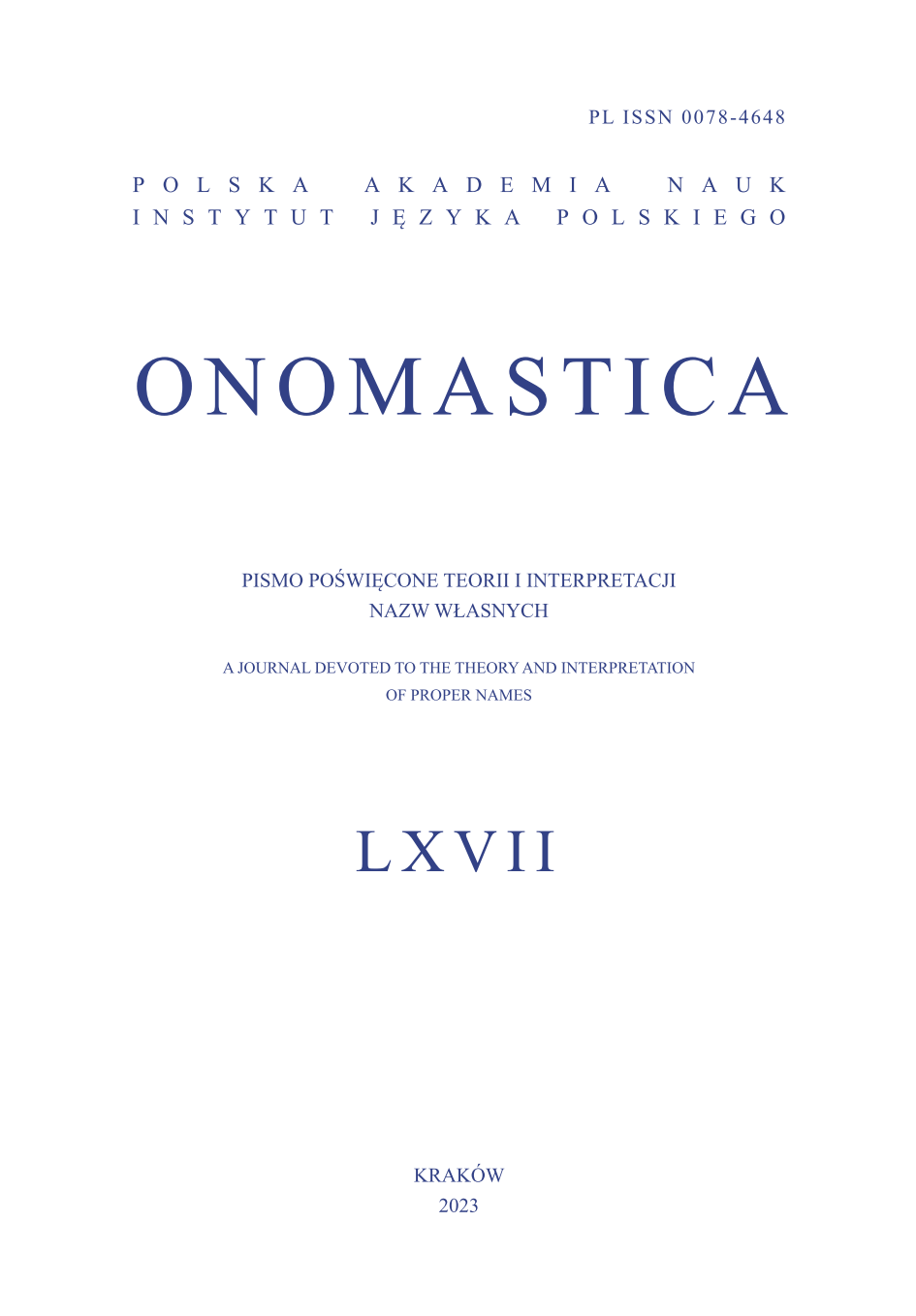Abstract
The onymic structure of a literary work — especially anthroponyms and toponyms — creates a functional system linked to the author’s poetics, stylistic and contemporary conventions, and also to a given literary genre or subgenre or modus. The genological aspects and motivations of the use of proper names in an artistic text are among the least treated in contemporary literary onomastics, although they touch upon a wide range of linguistic and literary scientific questions, perspectives and problems. In this regard, our comparative case study focuses on the recently highly productive genre area of dystopias and the analysis of its onymic landscape, namely abionyms; the corpus under study consists specifically of eleven Czech and French prose works published after 1989. Due to the nature of these related genres (among others, representation of the future, but often also in intermingling with the previous present, anticipatory construction, negative image of development striving for realism, believability), the paper focuses primarily on the distribution of the use of authentic and realistic, or authorial, names. The study observes the frequency of these proper names and their functions in (re)modelling the fictional world in relation to the actual world, with the intention of characterising any typical features, tendencies or variations. In this paper, we deliberately chose a comparative approach, which, we believe, more appropriately captures general patterns beyond the scope of individual national language systems — on this basis, the study concludes that the identified and interpreted characteristics of onymy can be assessed as immanent, generally valid in a given genological category of contemporary literature.
References
Andrevon, J.-P. (1989). Šukran [Shukran]. Paris: Éditions Denoël.
Berg, L.D., & Kearns, R.A. (2009). Naming as Norming: „Race“, Gender, and the Identity Politics of Naming Places in Aotearoa/New Zealand. In L.D. Berg & J. Vuolteenaho (Eds.), Critical Toponymies: The Contested Politics of Place Making (s. 19–51). Farnham: Ashgate.
Dvořáková, Ž. (2017). Literární onomastika: antroponyma [Literary onomastics: anthroponyms]. Praha: Filozofická fakulta Univerzity Karlovy.
Dvořáková, Ž. (2015). Jak dále v literární onomastice? [What next in literary onomastics?]. In H. Chýlová & V. Viktora (Eds.), Dva z prvních: Jaromír Spal, Miloslav Šváb — respektované osobnosti vysokoškolské bohemistiky [Two of the first: Jaromír Spal, Miloslav Šváb — respected personalities of academic bohemistics] (s. 92–99). Plzeň: Vydavatelství Západočeské univerzity v Plzni.
Frýbort, L. (2015). Pod znamením půlměsíce: příběhy z Evropy pod vládou islámu [Under the sign of the crescent: Stories from Europe under islamic rule]. Krásná Lípa: Marek Belza.
Gibka, M. (2019). Literary Onomastics: A Theory. Łódź: ArchaeGraph.
Houellebecq, M. (2015). Soumission [Submission]. Paris: Flammarion.
Houellebecq, M. (2015). Podvolení [Submission] (A. Beguivin, překl.). Praha: Odeon.
Kechlibar, M. (2019). Krvavé levandule [Bloody lavender]. Praha: Klika.
Odaloš, P., & Vallová, E. (2020). Sústava slovanskej onomastickej terminológie (vznik, existencia, neuralgické miesta, aktualizácia) [The System of slavic onomastic terminology (creation, existence, neuralgic points, revision)]. Folia onomastica Croatica, 29, 169–202.
Paitel, P. (2013). 2084 — République Islamique de France [2084 — Islamic Republic of France]. Bookelis.
Pastyřík, S. (2000). Vlastní jména v literatuře a škola [Proper names in literature and school]. Hradec Králové: Gaudeamus.
Pavlova, O. (2022). 2 + 2 = 5: světy antiutopické a dystopické literatury [2 + 2 = 5: Worlds of Antiutopian and Dystopian Literature]. Praha: Filozofická fakulta Univerzity Karlovy.
Rath, D. (2017). Řád [The Order]. Praha: Ottovo nakladatelství.
Rejter, A. (2019). Nazwy własne w kon/tekstach kultury [Proper names in con/texts of culture]. Katowice: Wydawnictwo Uniwersytetu Śląskiego.
Saint-Hamont, D. (2002). Le jour de l‘Aïd [The day of Eid]. Plon.
Sansal, B. (2015). 2084: la fin du monde [The end of the world]. Paris: Gallimard.
Sansal, B. (2016). 2084: konec světa [The end of the world] (R. Podaný, překl.). Praha: Argo. (Původní práce publikovaná v roce 2015)
Střelec, K. (2019). Stalingrad Pub or Hitler’s? Representation of ideological changes of toponyms in contemporary Czech literature. Acta onomastica, 60(1), 121–129.
Šlechta, V. (2015). Rok Havrana [Raven’s Year]. Praha: Brokilon.
Vergnenegre, A. (2020, 12. června). Marseille „la ville la plus dangereuse d‘Europe“, un classement américain basé sur un sondage d‘internautes. France Info. https://france3-regions.francetvinfo.fr/provence-alpes-cote-d-azur/bouches-du-rhone/marseille/marseille-ville-plus-dangereuse-europe-classement-americain-base-sondage-internautes-1544436.html
Vitkine, A. (2006). La Tentation de la défaite [The temptation of defeat]. Paris: Editions de La Martinière.
Vondruška, V. (2019). Kronika zániku Evropy: 1984–2054 [Chronicle of the end of Europze: 1984–2054]. Brno: MOBA.


